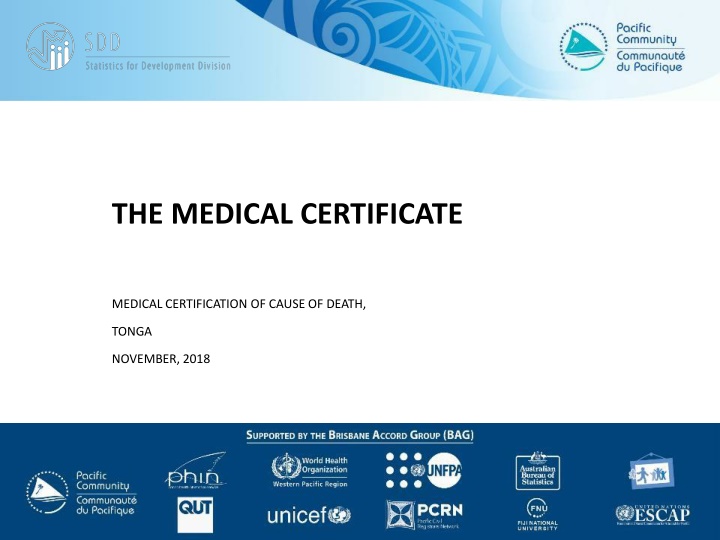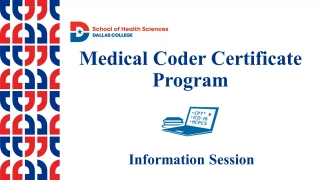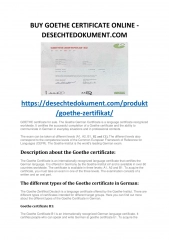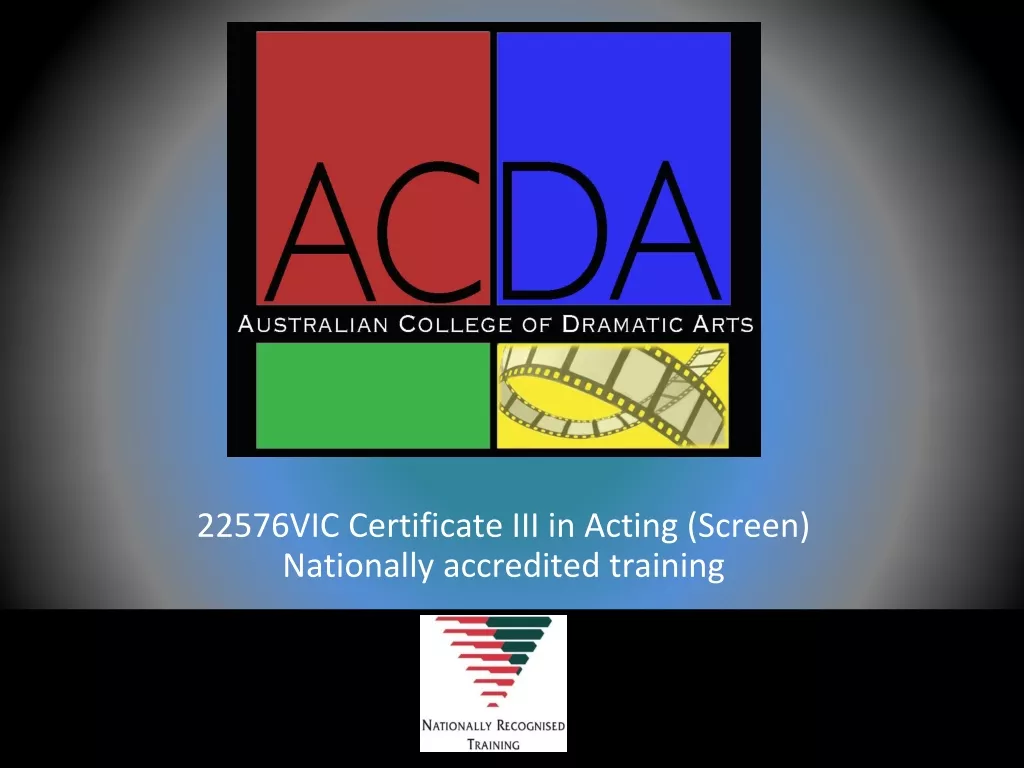THE MEDICAL CERTIFICATE
WHO provides standards for collecting data on causes of death through medical certificates. These certificates are used to classify and report causes of death in a standardized manner. They include administrative data, medical data, and responsibility guidelines for completion.
Download Presentation

Please find below an Image/Link to download the presentation.
The content on the website is provided AS IS for your information and personal use only. It may not be sold, licensed, or shared on other websites without obtaining consent from the author.If you encounter any issues during the download, it is possible that the publisher has removed the file from their server.
You are allowed to download the files provided on this website for personal or commercial use, subject to the condition that they are used lawfully. All files are the property of their respective owners.
The content on the website is provided AS IS for your information and personal use only. It may not be sold, licensed, or shared on other websites without obtaining consent from the author.
E N D
Presentation Transcript
THE MEDICAL CERTIFICATE MEDICAL CERTIFICATION OF CAUSE OF DEATH, TONGA NOVEMBER, 2018
THE WHO INTERNATIONAL CLASSIFICATION OF DISEASES Produced by the World Health Organization Classifies causes of death in a standardised way to facilitate production of comparable statistical data Includes recommendations regarding how causes of death should be recorded and reported utilising the Medical Certificate of Cause of Death Certificates can then be coded to the international standard and underlying cause of death used for reporting
2016 NEW DEATH CERTIFICATE PUBLISHED BY THE WHO Contains several parts: Administrative data (demographic information about the decedent) Frame 1 medical data relating to causes of death Frame 2 other medical data that is relevant to the death and which affects coding Countries can add additional data collection items as required
NEW DEATH CERTIFICATE Designed to be used for both adult and perinatal deaths Perinatal death certificate is no longer recommended Supports selection of the underlying cause of death for all deaths
ADMINISTRATIVE DATA Is there other administrative data that you think should be collected?
RESPONSIBILITY FOR COMPLETION OF MEDICAL CERTIFICATE OF CAUSE OF DEATH WHO recommends that the certificate is completed by: An experienced doctor who is familiar with the medical history of the decedent A coroner or medical examiner in cases of accidents, violence, unexpected deaths Another official (who may not be medically trained) in the absence of a doctor
COMPLETING THE CAUSES OF DEATH PART 1 #1 Two parts of medical certificate of cause of death for recording causes PART 1 has four lines for recording sequence of events leading to death The TERMINAL CAUSE (previously called the IMMEDIATE CAUSE - that is, the condition that directly led to death) is always recorded on line 1a This may be the only cause reported if there are no other conditions in the sequence
COMPLETING THE CAUSES OF DEATH PART 1 #2 Other conditions leading to the condition reported on line 1a are entered in sequence on lines 1b, 1c and 1d The condition that the certifier believes is the underlying cause is reported on the lowest used line this is also called the STARTING POINT The underlying cause has been defined as (a) the disease or injury which initiated the train of morbid events leading directly to death, or (b) the circumstances of the accident or violence which produced the fatal injury
INTERNATIONAL STANDARD MEDICAL CERTIFICATE OF DEATH FORM
COMPLETING THE CAUSES OF DEATH PART 1 #3 Diseases reported represent the best medical opinion of the certifier Any disease, abnormality, injury, poisoning or external cause should be reported if certifier believed it contributed to the death Well completed certificate provides an aetiological description of sequence of events that led to the death ie it is cause- based Should progress from Underlying cause or starting point Leading to any intervening causes Which led to the immediate cause or terminal cause
1 Time interval between onset and death Disease or condition (a) Acute on chronic renal failure directly leading to due to or as a consequence of death* Antecedent causes (b) Glomerulonephritis Morbid conditions due to or as a consequence of giving rise to the above cause, stating the underlying (c) .Diabetic nephropathy condition last due to or as a consequence of Acute on chronic renal failure 12 days 12 days Glomerulonephritis .. 1 year 1 year 5 years 5 years Diabetic nephropathy 10 years 10 years (d) Diabetes Type II 2 Other significant conditions Femoral neck fracture, femoral contributing to the death, fracture but not related to the disease Post operative haematoma condition causing it Diabetes Type II 1 month 1 month Femoral neck fracture, femoral fracturerepair, Post operative haematoma repair, *This does not mean the mode of dying e.g. heart failure, respiratory failure. It means the disease, injury or complication that caused death.
EXAMPLE 1 1a 1b 1c 1d heart failure carcinomatosis secondary in lung adenocarcinoma of colon 2 years 1 hour 4 weeks 6 weeks What do you think is the underlying cause of death?
EXAMPLE 2 1a Massive haemorrhage 1b Traumatic amputation of R leg 1c Bitten by shark What do you think is the underlying cause of death?
COMPLETING THE CAUSES OF DEATH PART 2 Used to record other significant conditions which contributed to the death but were not related to the condition that caused the death
EXAMPLE 3 1a 1b 1c 1d heart failure carcinomatosis secondary in lung adenocarcinoma of colon 2 years 1 hour 4 weeks 6 weeks 2 type 2 diabetes mellitus
YOUR RESPONSIBILITIES #1 Only record one cause on each line of the certificate in part 1 (you can record more than one in part 2) Unless there is a situation where two independent diseases contributed equally to the sequence at the same time Use as many of the lines in part 1 as are necessary to record the sequence Record the causes as specifically as possible more specific documentation improves the coding and subsequent utility of the data Don t record the mode of dying e.g. heart failure, respiratory failure. Record the disease/s, injury/ies or complication/s that caused death.
YOUR RESPONSIBILITIES #2 If the cause of death is unknown, it is correct to document Unknown or Not determined this is better than speculating In the case of injuries or poisonings, record: the nature of the injury (fracture, dislocation, laceration) AND the external cause (eg motor vehicle accident, fall from ladder, hit on head by coconut) Write legibly using blue or black ink Avoid using abbreviations
YOUR RESPONSIBILITIES #3 As well as the sequence it is important to be as specific as possible Examples: CANCER is only a little bit useful Lung cancer is much more useful for public health planning Hepatitis (without an underlying cause) codes to a completely different chapter than infectious hepatitis Conditions such as septicaemia, multi-organ failure and abscess are all missing important information Remember! The medical certificate of death is your best medical opinion
TRY TO CERTIFY THIS ONE Decedent was walking across the road when he was hit by a truck. He sustained multiple fractures (skull, ribs, right femur). He subsequently went into traumatic shock and died.
HAVE ANOTHER TRY Mr Smith was suffering from hepatitis B which led to cirrhosis of the liver. Because of the liver disease, he developed portal hypertension and subsequently oesophageal varices which haemorrhaged leading to his death.
TRY THIS ONE (DONT FORGET PART 2) Paul had been diagnosed with cardiomyopathy as a result of long term hypertension. He was admitted to hospital today with shortness of breath and swollen ankles. The doctor diagnosed congestive cardiac failure. Paul was a long term type 2 diabetic and also had significant dental caries. He died 12 hours after admission.
DURATIONS On the right hand side of the medical certificate is a column titled Time Interval from Onset to Death This is for recording the duration that the patient had the cause reported ie the time interval between when the condition is believed to have started (not necessarily when it was diagnosed) and when the death occurred The unit of time is also recorded minutes, days, months, years
EXAMPLE 4 1a 1b 1c 1d Pulmonary embolism Pathological fracture Secondary carcinoma of femur Carcinoma of breast (primary site) 18 months minutes 5 days 3 years Does this look correct? Why or why not?
WHY IS THIS IMPORTANT? Each death is counted ONCE in the national and international mortality statistics Selection of the Underlying Cause of Death is based on the concept of where in the causal sequence you would INTERVENE to prevent that happening to someone else There are rules for coders around how to select the underlying cause of death
CODING RULES FOR CAUSE OF DEATH The underlying cause is the last condition listed in Part 1 but ONLY if it can cause everything listed above The coder is looking for a PLAUSIBLE sequence starting on the top line and working backwards from the death eg 1a Lung Cancer 1b Ischaemic heart disease X not a plausible sequence lung cancer will be the underlying cause. IHD should appear in the contributory causes in Part 2
CODING RULES FOR CAUSE OF DEATH If there is more than one sequence the first reported sequence must be selected (ie the one on the furthest left) This means if there are two causes on one line only ONE can be used, as the sequence works down the line, not across the line If there is no sequence the first reported condition is selected as the tentative underlying cause If the tentative cause was clearly due to something else reported on the certificate the coder will apply rules to select that other condition
ANSWER? Pulmonary distress Left lobe pneumonia Metastasised cancer in lungs x COPD Thyroid cancer Underlying cause of death: Thyroid cancer
CODING RULES FOR CAUSE OF DEATH Ill-defined conditions are ignored Trivial conditions are ignored These include: MODE of death cardio-pulmonary arrest SYMPTOMS AND SIGNS Fever, headache, pain THINGS THAT GENERALLY DON T KILL YOU broken finger NON-SPECIFIC CONDITIONS THAT CAN T BE CODED old age , senility , viral illness
WHAT IS CODED? All conditions mentioned on the certificate first Then we use the coding rules to determine the underlying cause of death Wait for it this will scare you!
see section 4.3 Coding Instructions for mortality: multiple causes Annex 7.10 Workflow diagram of the application of the coding instruction for the selection of underlying cause of death First assign ICD codes to all conditions mentioned in the death certificate SP 1 Notes: Refer to 4.1.3 for basic concepts: Sequence Causal relationship Duration Terminal cause of death Starting point Tentative Starting Point: TSP Obvious cause First-mentioned sequence Yes Choose the condition as the starting point. Go to M1. Only one condition, either in Part 1 or 2? First-mentioned condition Underlying cause of death: UCOD Modification Tentative underlying cause of death: TUC Two or more No SP 2 Choose the first mentioned condition as the TSP Go to SP6 How many conditions are mentioned on this line? Yes Only one line used in Part 1? Choose single condition in Part 1 as the TSP. Go to SP6. One, but one or more in Part 2. No 4.2.1 Find the starting point (Steps SP1 to SP8) Condensed title of each step in 4.2.1 SP 3 Does the first condition on the lowest line explain all entries above? see also Yes Choose that condition as the TSP. Go to SP6. SP1 Single cause on certificate SP2 Only one line used in Part 1 No SP3 First cause on the lowest line explains all entries above (Try to get clarification from the certifier) SP 4 Is there a sequence ending in the terminal condition? Yes Choose the starting point of this sequence as the TSP. Go to SP6. Section 4.2.3 Yes A sequence ends with the terminal condition SP4 Is there only one sequence? Identify the first mentioned sequence, and choose the starting point of that sequence as the TSP. Go to SP6. SP5 No sequence in Part 1 No No SP6 Obvious cause Section 4.2.4 SP5 Annex 7.3 SP7 Ill-defined conditions Choose the terminal condition as the TSP. Go to SP6. Conditions unlikely to cause Annex 7.4 SP8 death Search for an obvious cause of the TSP, first in the same line in Part 1, next on lower lines in Part 1, and finally in Part 2. Choose the first mentioned obvious cause as a new TSP, and check again. In Part 1 Yes SP6 Was there another condition reported on the same line or further down that could have obviously caused the TSP? Are there several possible obvious causes? Yes Where is the TSP? (Carefully follow instructions in SP6 ) Choose the obvious cause as a new TSP, and check again. Search for an obvious cause of the TSP only in Part 2. No In Part 2 No Keep the TSP as the starting point. Go to M1. Yes SP 7 Is the TSP an ill-defined condition? (Annex 7.3) Are other conditions mentioned in the certificate all ill-defined? Yes Disregard this ill-defined TSP. Go back to SP1. No No SP 8 Is the TSP a condition unlikely to cause death? (Annex 7.4) Are other conditions mentioned in the certificate all ill-defined, or unlikely to cause death? Is the TSP the cause of the condition that is not ill-defined or unlikely to cause death? Yes Keep the TSP as the starting point. Go to M1. Was the death caused by a reaction to treatment of the TSP? No Yes No Disregard this TSP unlikely to cause death. Go back to SP1. Yes Yes No No Keep the TSP as the starting point. Go to M1. Select the reaction to treatment as the starting point. Go to M1.
TSP identified by SP1 to SP8 is now considered the tentative underlying cause (TUC). M1 Special Instructions Does any Yes Assign a new TUC and check again. Carefully follow the instructions in M1 and refer to 4.2.5 Special instructions on linkages and other provisions special coding instruction apply to the TUC? No M2 Specificity 4.2.2 Check for modifications of the starting point (Steps M1 to M4) Is there Yes Assign a new TUC and check again. a more informative term than the TUC? No M3 Recheck The TUC selected in M1 or M2 is not ill-defined and is reported correctly due to another condition Is the TUC same as the starting point identified by SP1 to SP8? The TUC is a reaction to treatment of a condition unlikely to cause death selected in SP8 Go back to SP6. Repeat the procedures in SP6, M1 and M2. No No No Yes Yes Yes M4 Medical procedures, poisoning, main injury, maternal death TUC is Special instructions Refer to section Surgery or medical procedure 4.2.9 Other medical procedures Does the Follow instructions and refer to sections indicated in the following table. Yes TUC apply either of the special instructions for M4? Chapter XIX Injury or poisoning Code the external cause as the UCOD Chapter XX External cause Also select the main injury. 4.2.6 Main injury in death from external causes No Confirmation: The TUC is not further changed in either SP6 or M1 to M3 Poisoning and more than toxic substance is reported Identify the most important drug involved. 4.2.7 Poisoning by drugs etc. Yes Decedent is a woman and pregnancy, childbirth or pueperium is reported. Determine whether to assign Chapter XV as the UCOD 4.2.8 Maternal mortality The TUC is the underlying cause of death.
CODING RULES - FINDING THE STARTING POINT Series of rules to determine the underlying cause of death from a medical or aetiological perspective Step SP1 Single cause on certificate Step SP2 Only one line used in Part 1 Step SP3 More than one line used in Part 1, first cause on lowest line explains all entries above Step SP4 First cause on lowest used line does not explain all entries above, but a sequence ends with the terminal condition Step SP5 No sequence in Part 1 Step SP6 Obvious cause Step SP7 Ill-defined conditions Step SP8 Conditions unlikely to cause death
CODING RULES - CHECKING FOR MODIFICATIONS Series of rules to determine underlying cause of death from a statistical perspective Step M1 Special instructions Step M2 Specificity Step M3 Recheck Steps SP6, M1 and M2 Step M4 Instructions on medical procedures, poisoning, main injury and maternal deaths
RESOURCES Quick reference tool how to complete a medical certificate http://mspgh.unimelb.edu.au/__data/assets/pdf_file/0007/2329981/CoD_ReferenceGuide_20170402.pdf WHO on line training tool http://apps.who.int/classifications/apps/icd/ICD10Training/ICD-10%20Death%20Certificate/html/index.html Hawaii State on line training tool http://cod.doh.hawaii.gov/ CDC Physicians handbook https://www.cdc.gov/nchs/data/misc/hb_cod.pdf University of Queensland/ WHO Handbook on medical certification http://getinthepicture.org/sites/default/files/resources/Handbook%20for%20doctors%20on%20cause-of- death%20certification.pdf D4H Handbook on medical certification http://mspgh.unimelb.edu.au/__data/assets/pdf_file/0006/2087430/COD_RT1_Handbook_101604.pdf























